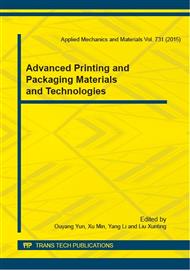p.265
p.269
p.273
p.277
p.283
p.287
p.291
p.295
p.300
Exploration of Factors to Influence Solid Density Based on the Xerographic Toner Digital Printing Field
Abstract:
With the rapid development of the printing industry, relying on its flexibility and advantage for short-run printing, the use of digital printing in various areas of the market becomes more widely. Digital print quality evaluation and control is particularly important. Among them, the solid density is an important indicator of print quality evaluation. Using different digital printing methods, the factors to influence the density is different. In this paper, two factors that affect xerographic toner solid density were discussed base on the principle of electrostatic imaging and toner transfer and fusing process. Experiments analyzed different transfer supply voltage conditions on CMYK four-color solid density; and the fusing temperature on CMYK four-color solid density. The results showed that: transfer supply voltage and fusing temperature are influential factors on the four-color solid density.
Info:
Periodical:
Pages:
283-286
Citation:
Online since:
January 2015
Authors:
Price:
Сopyright:
© 2015 Trans Tech Publications Ltd. All Rights Reserved
Share:
Citation:


